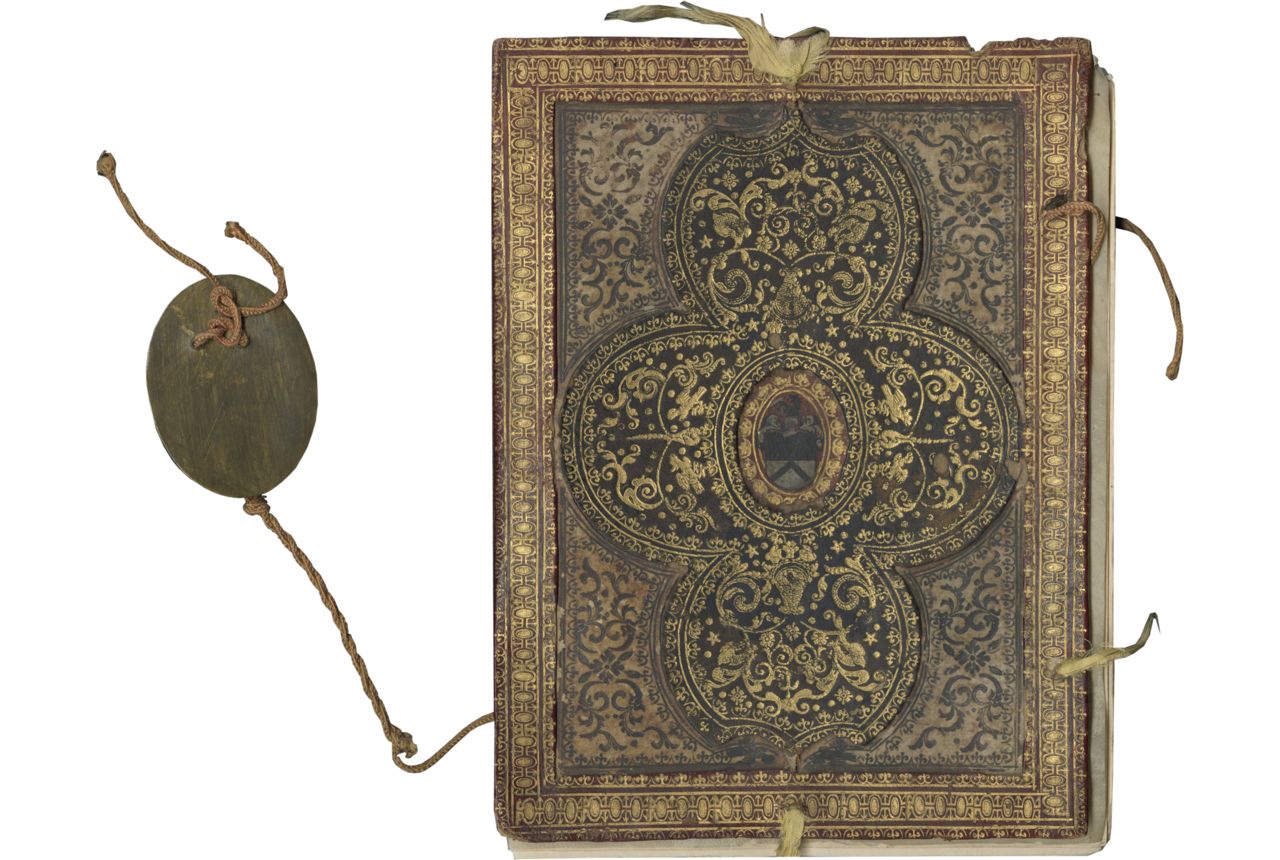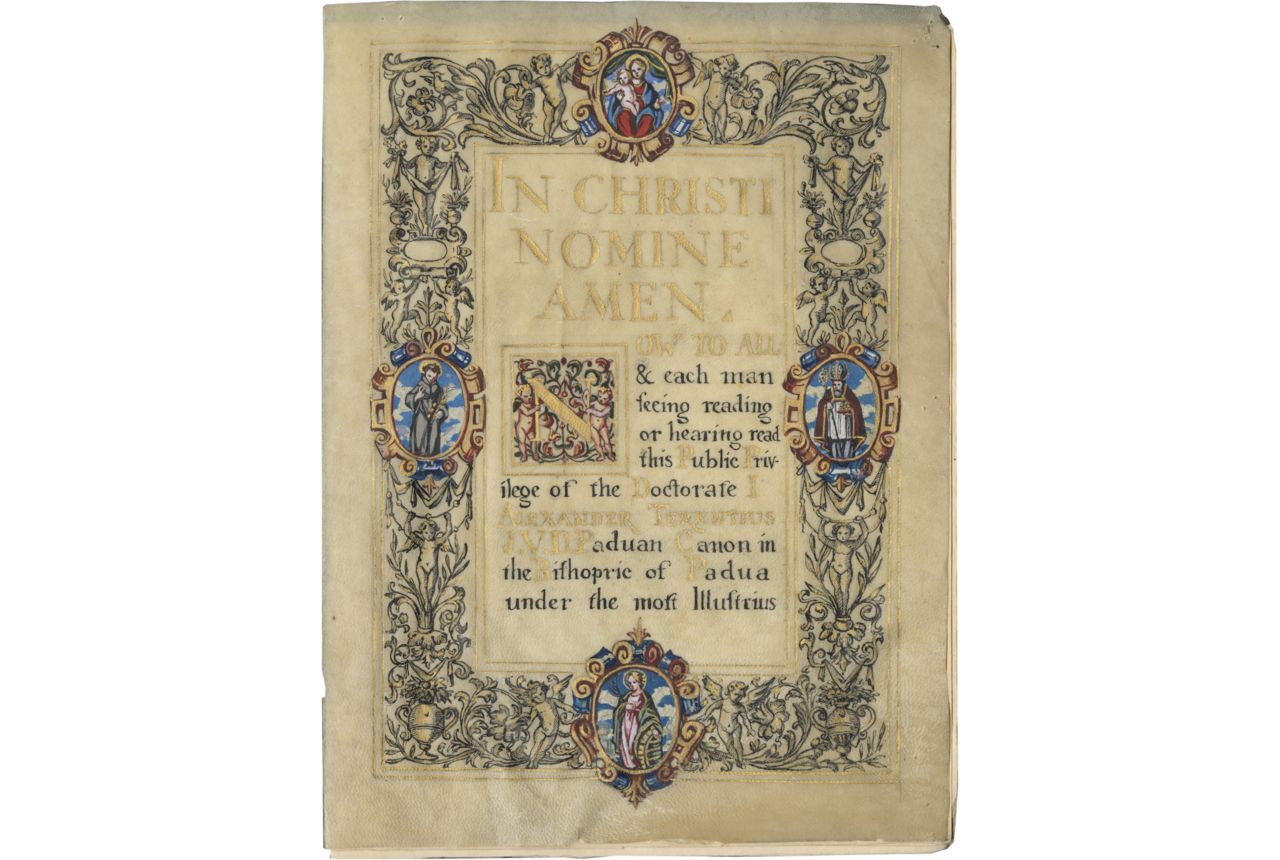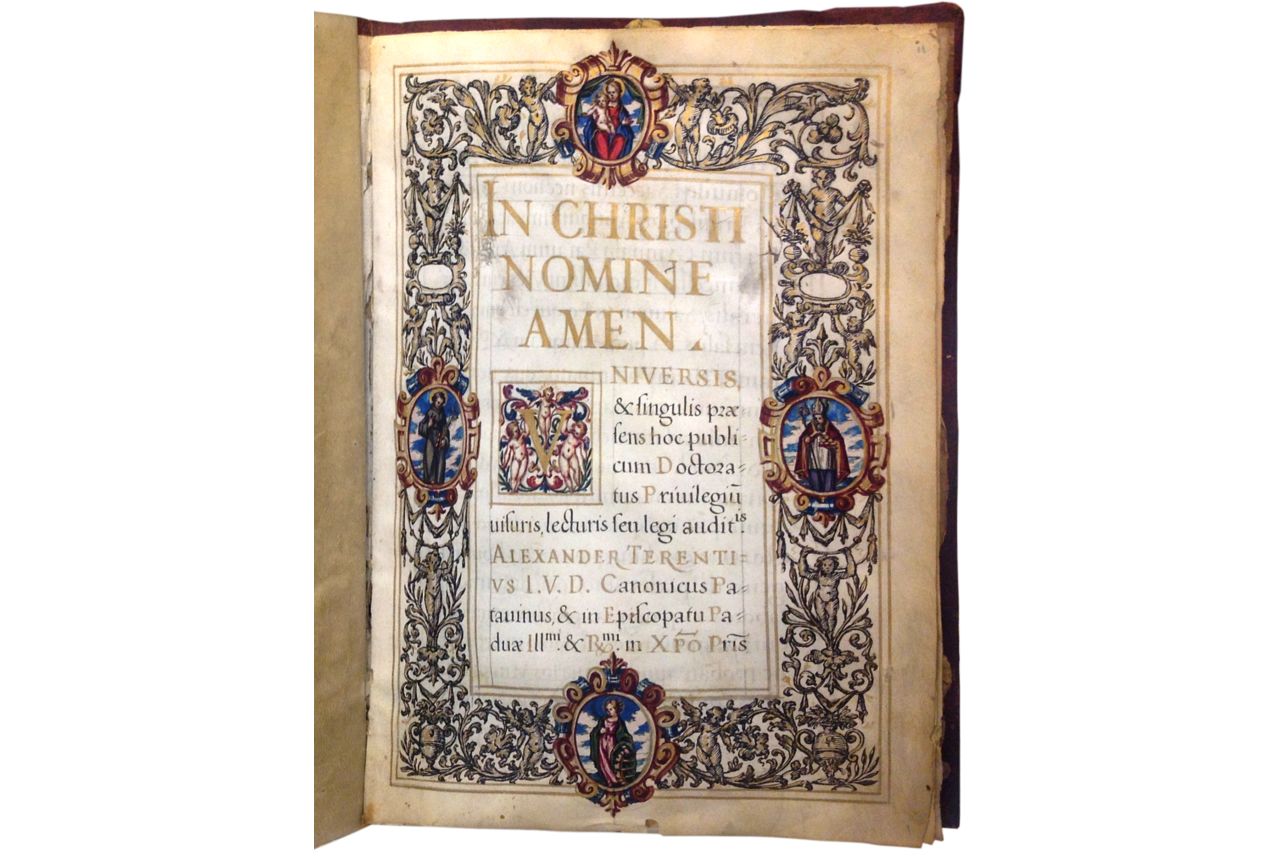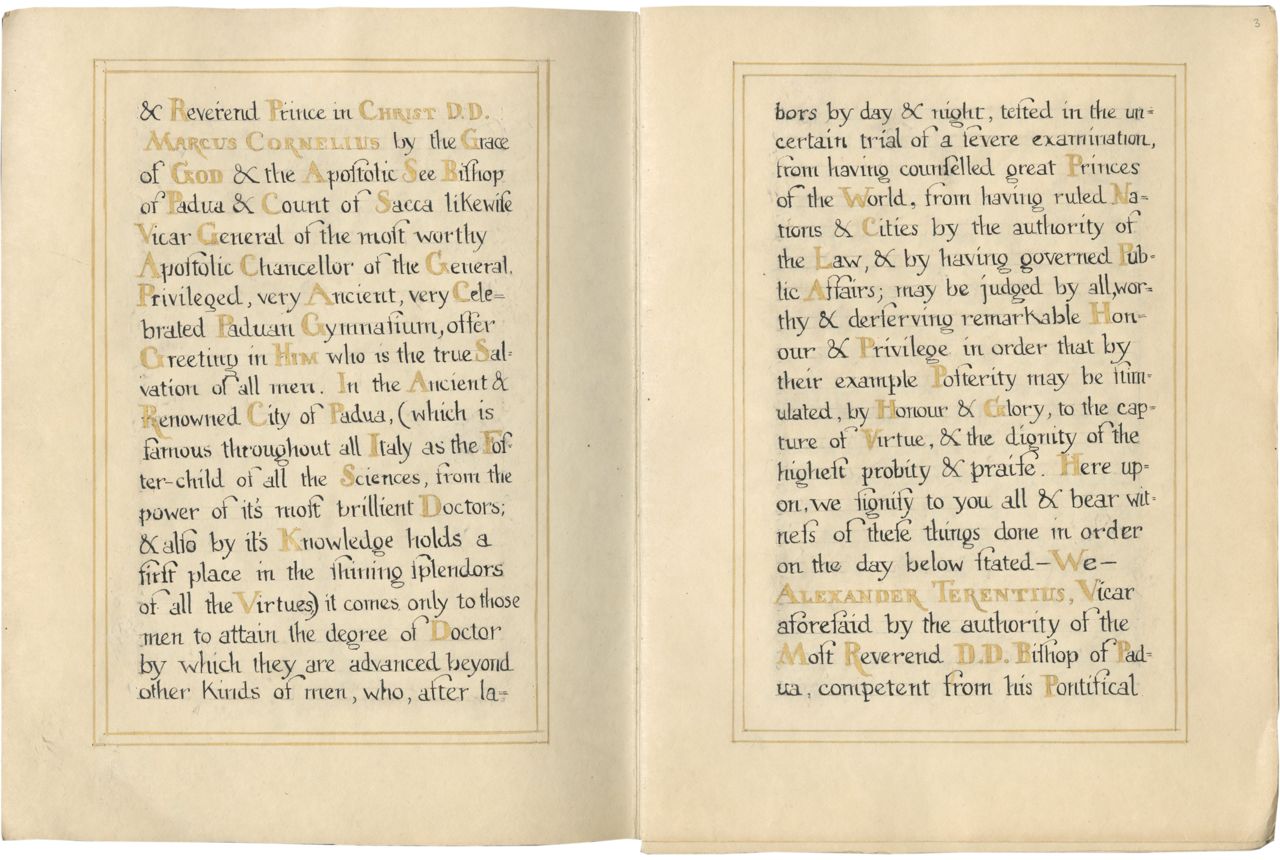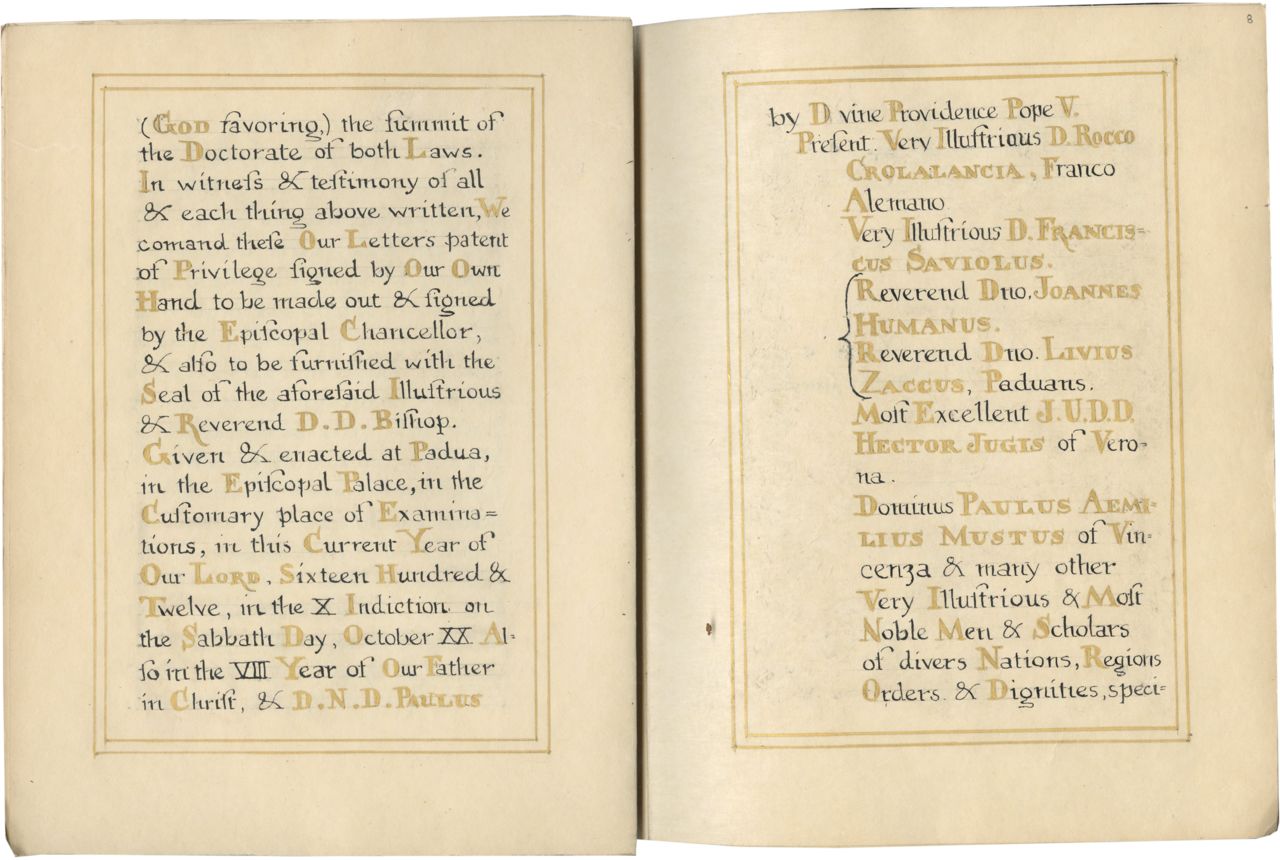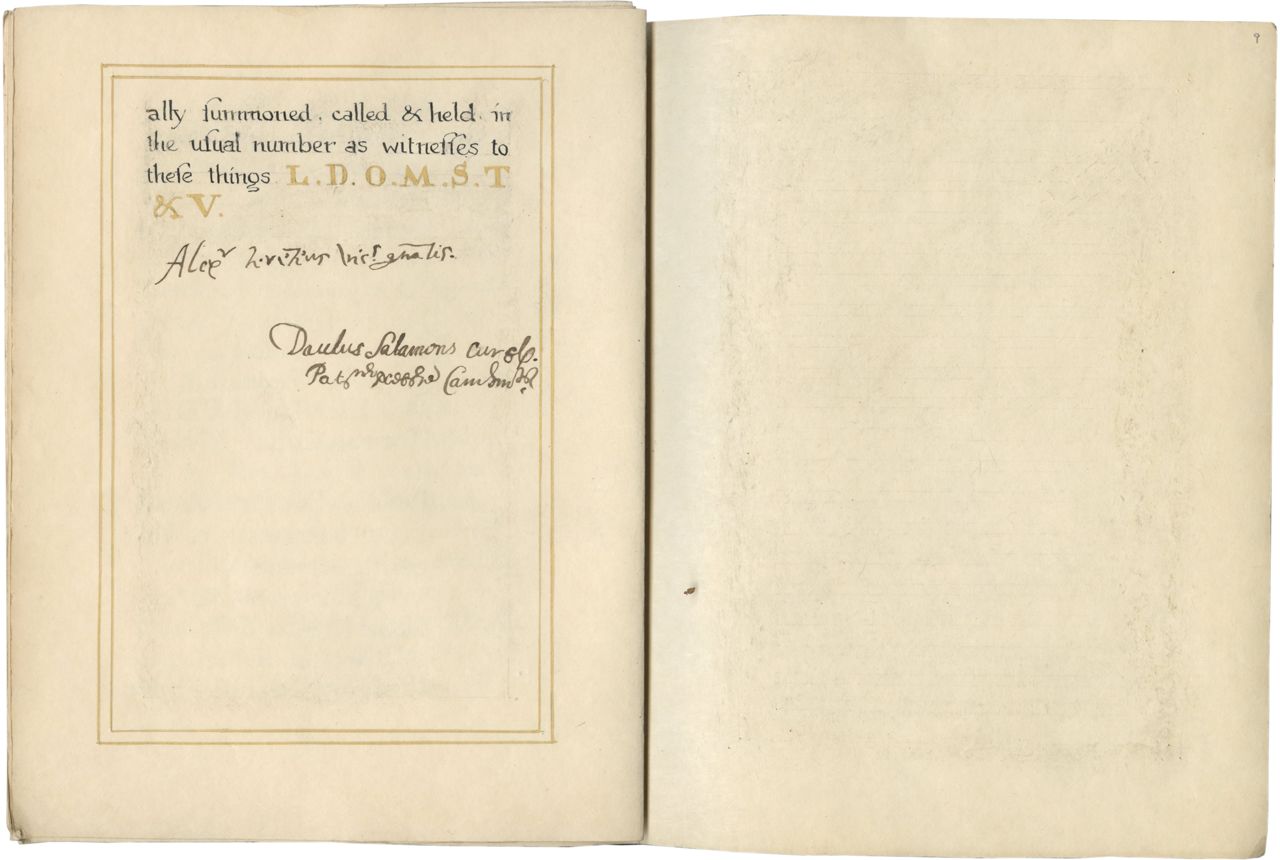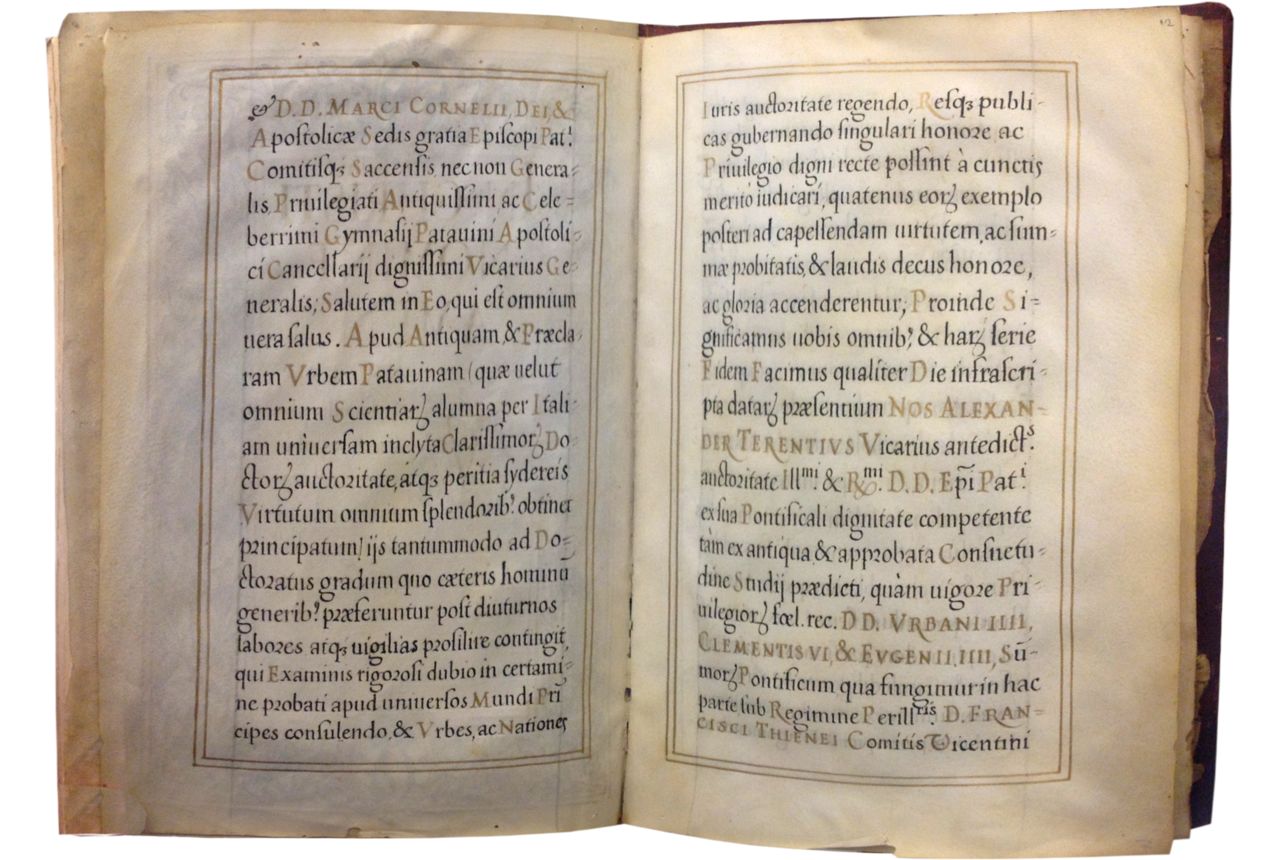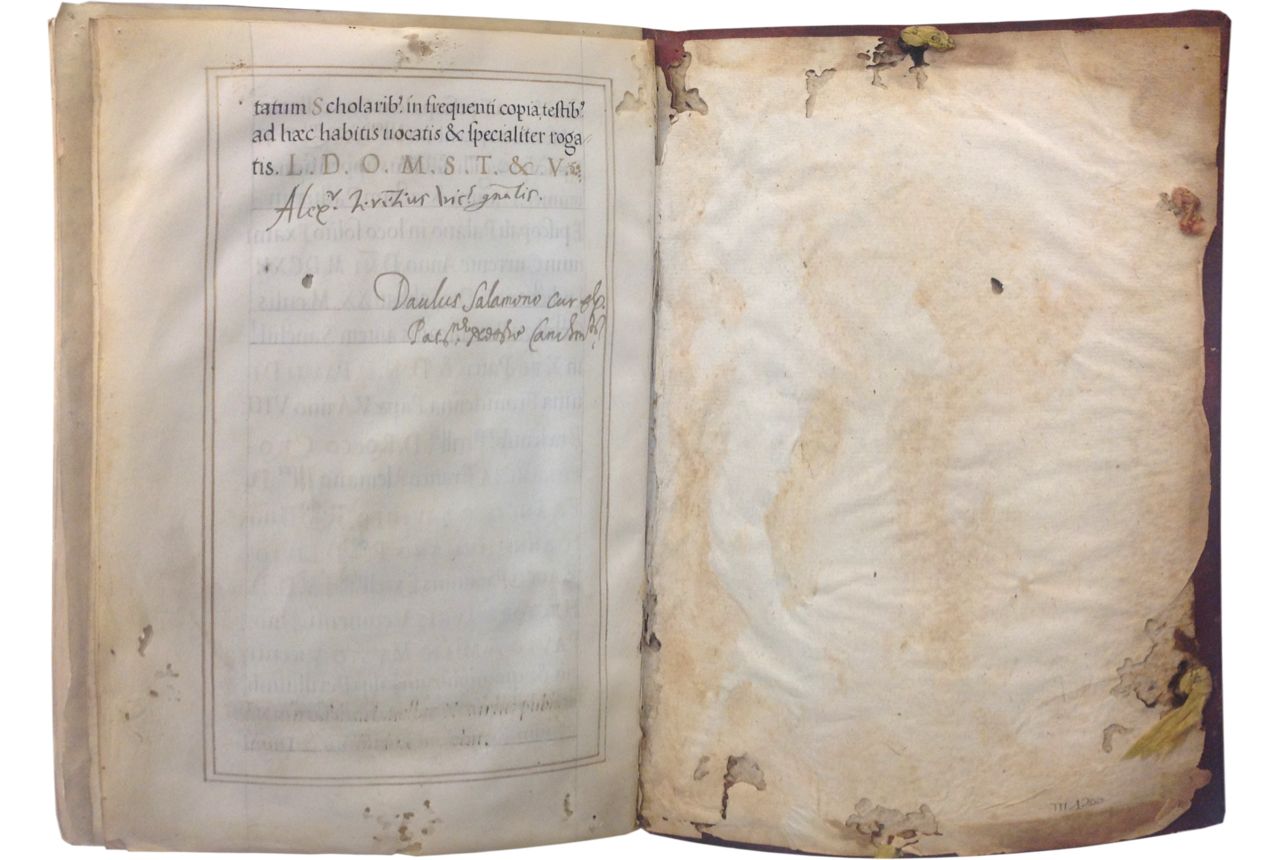16 folios, including a quire of 10 leaves, outer bifolium parchment, otherwise paper (19-century addition inserted in the beginning of the volume, not bound) and 6 original folios on parchment, modern foliation in pencil, 1-16, complete (collation i10 ii6), ruled in lead point (justification 188 x 124 mm.; facsimile 191 x 127 mm.), written in black ink in humanistic bookhand in single column on 20 lines, facsimile written in black ink in the nineteenth century imitating the humanistic hand of the diploma in single column on 20 lines, the headings, opening lines as well as names of persons and initials for important words in large Roman capitals in liquid gold throughout, a border of double lines in liquid gold enclosing the text block throughout, ILLUMINATED FRONTISPIECE with a 5-line initial in liquid gold held by two winged putti within frames of liquid gold infilled with foliage in red and blue and a FULL BORDER with numerous putti, amphorae, flowers, birds, and acanthus foliage painted in camaïeu d’or, and four framed medallions in gold and colors enclosing the Virgin and Child, an unidentified pope or bishop saint, St. Catherine of Alexandria and St. Anthony of Padua (f. 11), the nineteenth-century facsimile reproduces the border and initial almost exactly (f. 1), some edges of the leaves frayed, some wormholes, especially on the last leaf, otherwise in excellent condition. In its ORIGINAL VENETIAN SUNK-PANEL BINDING of red and brown morocco over pasteboards, both covers are entirely filled with gold and silver tooling with arabesque branches, birds, buds, small stars, flowers and dots, raised outer frame, a large lobed panel with a central sunken lozenge containing the hand-painted Vecellio coat of arms, sunken corner panels of silver-tooled parchment, flat spine, four pairs of yellow silk ties (very worn and one pair renewed), remnants of wax seal in brass case, small losses to leather, spine splitting, silver oxidized, otherwise in very good condition. Dimensions 231 x 170 mm. (facsimile 239 x 177 mm.).
Especially handsome diploma, awarding a doctorate in civil and canon law and made for a close relation of the great painter Titian. It preserves its original elaborately decorated sunk-panel binding, a magnificent example of the Venetian Renaissance craftsmanship influenced by Middle Eastern style. University diplomas constitute a rich mine of resources as historical documents and as artifacts. The accompanying facsimile with a translation of the Latin text into English makes this manuscript especially suited for use in the classroom and in exhibits.
Provenance
1. The doctoral diploma of civil and canon law was granted by the University of Padua to Alessandro Vecellio from Pieve di Cadore in the province of Belluno in Veneto in north-eastern Italy. The diploma is signed by Alessandro Terenzio, a university official, and dated October 20, 1612.
2. The facsimile of the diploma, containing a translation of the text into English and reproduction of the decoration (almost exactly), was made in the nineteenth century and inserted into the beginning of the volume.
Text
ff. 1-8v, [19th-century addition: facsimile with an English translation of the diploma; ff. 1v-2, blank; f. 2v], incipit, “In Christi nomine amen. Now to all & each man seeing reading or hearing read this Public Privilege of the Doctorate I Alexander Terentius J. V. D. Paduan Canon in the Bishopric of Padua ... & Reverend Prince in Christ D. D. Marcus Cornelius by the Grace of God ... summoned, called & held in the usual number as witnesses to these things”; [ff. 9-10v, blank];
ff. 11-16v, [Doctoral diploma of Alexander Vecellio], incipit, “In Christi nomine amen. Universis, & singulis praesens hoc publicum Doctoratus Privilegium visuris, lecturis seu legi auditis. Alexander Terentianus I. V. D. Canonicus Patavinus, & in Episcopatu Paduae ... [f. 12v] per Venerandum Collegium Excelletissimor I. V. Doctorum Gymnasii praedicti IIIrem D. Alexandrum Vecellium Cadubriensem Perillustris Equitis D. Titiani filium ... [f. 15v] Sic itaque summa cum laude, & honore plurimo dictus Excellentissimus D. Alexander Vecellius ad summum Doctoratus apicem Utriusque Juris Deo favente pervenit ... [f. 16] Datum & actum Paduae in Episcopali Palatio in loco solito Examinum Currente Anno Domini M.DC.XII. Indictione X Die Sabbati XX. Mensis Octobris ... Scholaribus in frequenti copia testibus ad haec habitis vocatis & specialiter rogatis. L. D. O. M. S. T. & V.”; [followed by the signatures of Alessandro Terenzio, the Paduan canon and vicar of the bishopric of Padua representing the Bishop of Padua, Marcus Cornelius, whose red wax seal authenticates the diploma, and of Daulus Salamono, another Paduan canon].
Alessandro Vecellio was granted a doctorate in civil and canon law by the University of Padua in 1612. He was born in Pieve di Cadore and was probably the son of Tiziano Vecellio l’Oratore (1538-1612), cousin of the great painter Titian (Tiziano Vecellio). Tiziano the Orator was a distinguished man of letters, who held important public offices in Cadore and Venice, and was honored with the title of Knight of San Marco in 1577. The title, Orator, had been given to his father for having held the address with which the Cadore people hailed Doge Alvise Mocenigo after the victory in the battle of Lepanto (1571). His mid-sixteenth-century house survives in Pieve and includes a very fine study with cornices in Castellavazzo stone vaults frescoed with allegories and grotesques by his famous cousin, the painter. The furniture decorating the rooms, including fine fabrics, majolica stoves, paintings by Titian, and old books, were divided among the heirs in 1625. Marco Corner, bishop of Padua (1594-1625) when this diploma was granted, was a descendant of the Cardinal Corner painted by Titian and his workshop in 1520 in Girolamo and Cardinal Marco Corner Investing Marco, Abbot of Carrara, with his Benefice (Washington, National Gallery of Art).
Alessandro held various public offices in Pieve and the Cadore area, such as commissari for the region of Cadore (Almanacco 1834, p. 77). The Italian historian and diplomate Enrico Caterino Davile refers in a letter dated 3 January 1616 to Alessandro as “erudito locale,” with whom he had been discussing the Istoria during walks, a two-volume work on the French civil wars that Davile completed about 1630 (Davile, Online Resources).
The very beautiful binding of our manuscript is noteworthy, and somewhat unusual on a diploma from the University of Padua. Sunk-panel bindings were a lavish book binding style developed in Venice between the middle of the sixteenth century and the beginning of the seventeenth century. Relying on Islamic artisanship and decoration, they offer an interesting ground for studying Persian and Ottoman motifs in Venetian art and artifacts. The sunk-panel bindings were used especially for official Venetian documents.
Founded in 1223, the University of Padua is one of the oldest European universities and the second oldest in Italy. For a doctoral diploma granted in the same year to Alessandro’s fellow student in law, Antonio Butta, also from Belluno, see the manuscript, formerly Les Enluminures TM 272 (Online Resources). Doctoral diplomas from early modern Italy, which survive in both private and institutional collections, have gained scholarly attention in recent decades. Studies have focused on a broad range of topics, from their value as historical and institutional sources to their interest as artifacts, studied for their script, illumination, and binding (see, for example, Baldissin Molli, 1998, Farina and Pivato, 2005, and Maggiulli, 2016). While some diplomas were written on flat sheets, as they appear today, diplomas in quarto format, usually illuminated and elaborately bound, appear c. 1580-90 in northern Italian universities and maintained this presentation into the nineteenth century.
Illustration
The illuminated border on the opening page of the diploma includes in roundels surrounding the text the patron saint of Padua, St. Anthony, as well as St. Catherine of Alexandria, the patron saint of the University of Padua.
Literature
Almanacco per le provincie, Venice, 1834.
Baldissin M. Giovanna, Luciana Sitran Rea, and Emilia Veronese Ceseracciu, eds., Diplomi di Laurea all’ Università di Padova (1504-1806), Padua, 1998.
Contadini, A. “’Cuoridoro’”: tecnica e decorazione di cuoi dorati veneziani con influssi islamici,” Arte Veneziana e Arte Islamica. Atti del primo Simposio internazionale sull’arte veneziana e l’arte islamica, ed. by E. J. Grube, Venice, 1989, pp. 231–251.
Cristoforetti, G. “I diplomi di laurea padovani del fondo Diplomi della Biblioteca Civica da Rovereto,” Quaderni per la storia dell’università di Padova 30 (1997), pp. 227-234.
Del Negro, P. “Lo scrittore-miniatore di diplomi di laurea tra Sei e Settecento: da mestiere senzalcuno impedimento a carica di un deputato,” Quaderni per la storia dell’università di Padova 36 (2003), pp. 109-134.
Farina, F. and S. Pivato, eds. Honor et meritus: diplomi di laurea dal XV al XX secolo: mostra documentaria realizzata in occasione del 500 anniversario della fondazione dell'Università degli studi di Urbino, Rimini, 2005.
Grube, E. J. “Le lacche veneziane e i loro modelli islamici,” Arte Veneziana e Arte Islamica. Atti del primo Simposio internazionale sull’arte veneziana e l’arte islamica, ed. by E. J. Grube, Venice, 1989, pp. 217–229.
Grube, E. J. “La “lacca” e la rilegatura veneziana nel XVI secolo,” Venezia e l’Islam 828-1797, ed. by S. Carboni, Venice, 2007, p. 274.
Maggiulli, I., ed. Diplomi di laurea. Conservati nell'Archivio storico dell'università di Bologna, Rimini, 2016.
Nuvoloni, L. “Commissioni Dogali. Venetian bookbindings in the British Library,” For the Love of the Binding: Studies in bookbinding history presented to Mirjam Foot, ed. by D. Pearson, London, 2000, pp. 81–109.
Piovan, F. and L. Sitran Rea, eds. Studenti, Università, Citta nella storia padovana: atti del convegno di studi, Padova, 5-8 febbraio 1998, Trieste, 2001.
Ticozzi, S. Vite dei pittori Vecelli di Cadore, vol. 4, Milan, 1817, p. 56.
Varanini, G. M. “I diplomi di laurea padovani del fondo Lauree dell’Archivio di Stato di Verona,” Quaderni per la storia dell’università di Padova 29 (1996), pp. 171-190.
Online Resources
“Enrico Caterino Davile,” Treccani (a contemporary of Vecellio)
https://www.treccani.it/enciclopedia/enrico-caterino-davila_%28Dizionario-Biografico%29/
Center for the Study of the University of Padua
http://www.centrostoria.unipd.it/
Les Enluminures TM 272
https://www.textmanuscripts.com/medieval/diploma-padua-university-60560
TM 1200


